
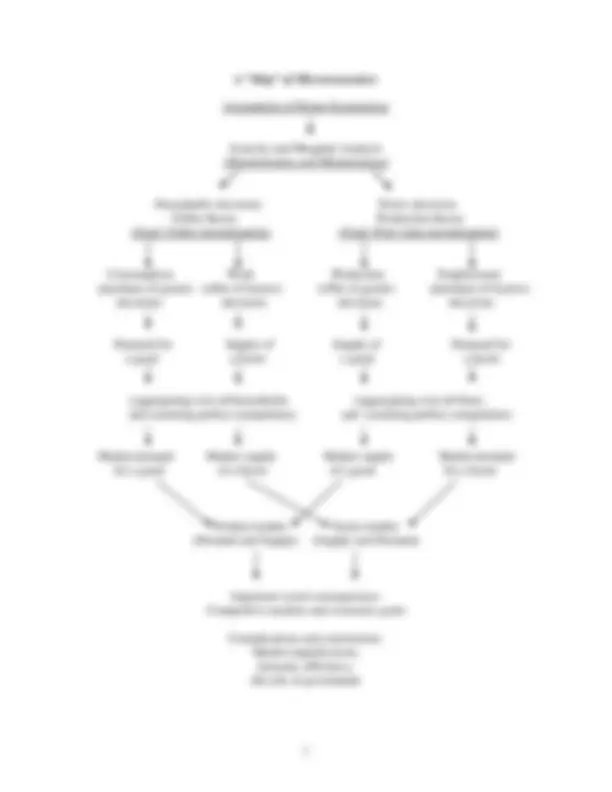
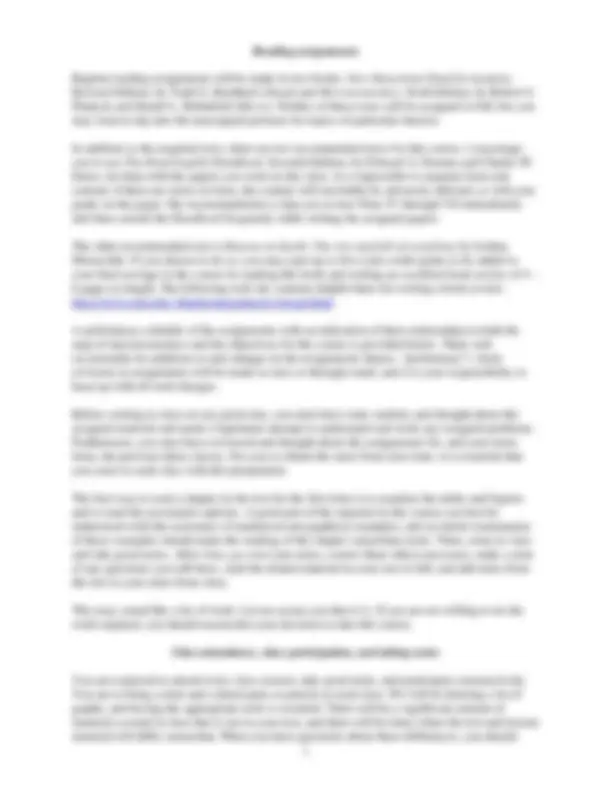
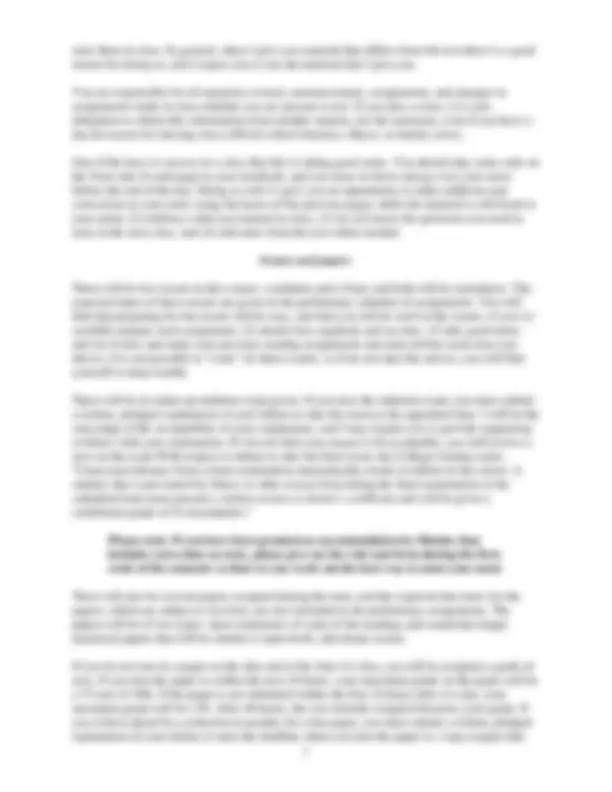
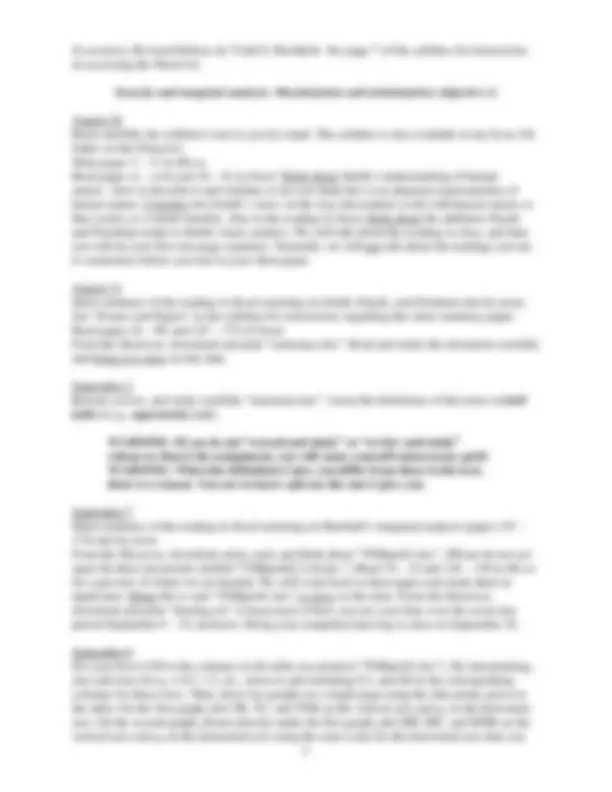
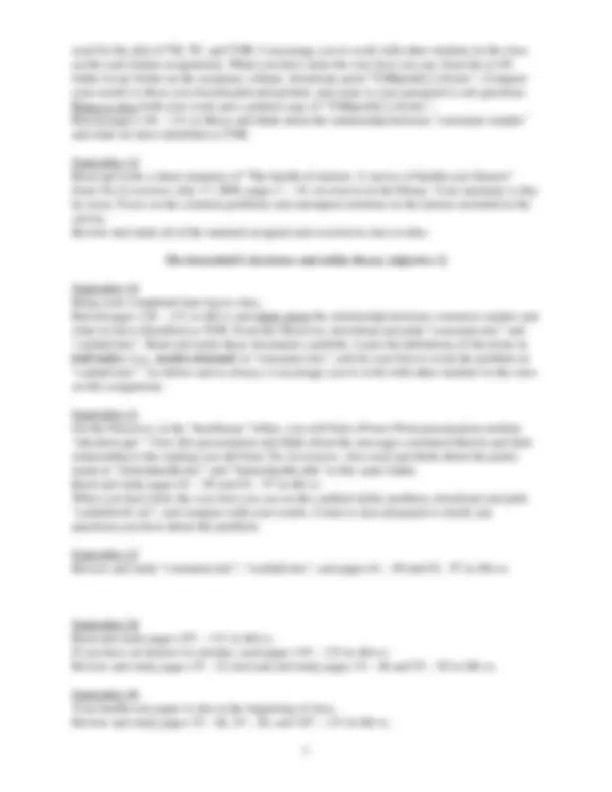
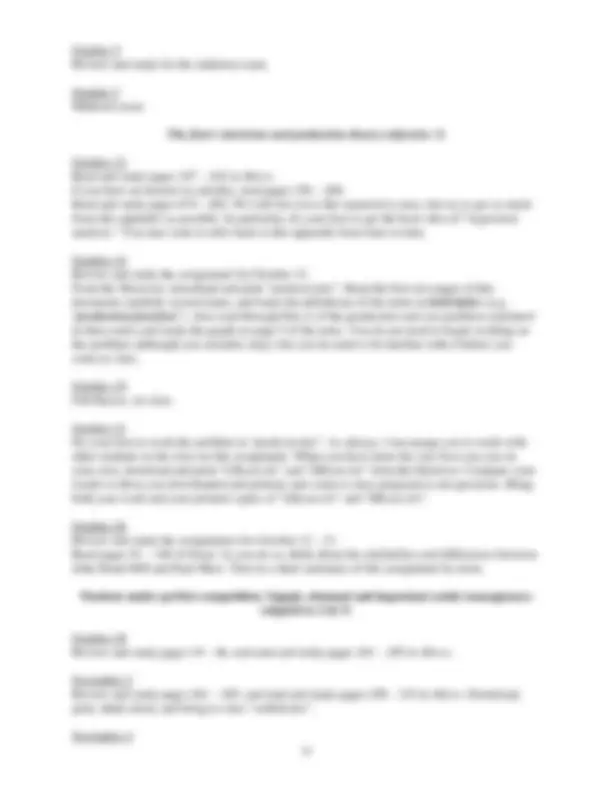


Study with the several resources on Docsity

Earn points by helping other students or get them with a premium plan


Prepare for your exams
Study with the several resources on Docsity

Earn points to download
Earn points by helping other students or get them with a premium plan
Community
Ask the community for help and clear up your study doubts
Discover the best universities in your country according to Docsity users
Free resources
Download our free guides on studying techniques, anxiety management strategies, and thesis advice from Docsity tutors
Material Type: Exam; Class: INTRODUCTION TO ECONOMICS; Subject: Economics; University: Rhodes College; Term: Unknown 1989;
Typology: Exams
1 / 11

This page cannot be seen from the preview
Don't miss anything!







Economics 101 Professor McMahon
Brief description of course
Economics 101, the first of two semesters of economic principles, is an in-depth introduction to m i croeconomic theory and its applications. The second semester, Economics 102, introduces the student to m a croeconomic theory and policy.
M i croeconomics is the study of the behavior of individuals in their roles as consumers, workers, producers, employers, and so on—in what Alfred Marshall called “the ordinary business of life.” For households, ordinary business includes making decisions about what goods and services to buy and in what amounts, how much of our income to give to others, and how many hours of work to offer. For firms, ordinary business includes decisions about what goods and services to produce for sale and in what amounts, and how much labor and capital to employ in order to do so. This focus on individuals (consumers, workers and the firm’s decision makers) does not mean, however, that there is no aggregation; a certain amount of aggregation occurs when we examine markets in which a number—possibly a very large number—of buyers and sellers interact. Aggregation over the economy as a whole , however, is the realm of m a croeconomics.
A necessary condition for success in this course is demonstration of mastery of the economic theory presented. Such demonstration includes not only the ability to explain the theory clearly but also the ability to use the theory to analyze the changes in behavior of economic actors in response to changes in circumstances and to explain the short-run and long-run consequences for the material welfare of society (i.e., of the individuals who make up the society).
Beyond this, however, the successful student will learn how economists think about the problems we encounter in the pursuit of a variety of personal and social goals. This “economic way of thinking” is useful in analyzing an amazingly large number of situations, not all of which are obviously economic , and certainly not exclusively economic , in nature (e.g., the commission of certain types of crime and ways to discourage such behavior). Judge Richard A. Posner (U. S. Court of Appeals for the Seventh Circuit), one of the founders of the field of “law and economics,” makes the point as follows:
Although the traditional subject of economics is... the behavior of individuals and organizations in markets, a moment’s reflection on the economist’s basic analytical tool
... will suggest the possibility of using economics more broadly. That tool is the assumption that people are rational maximizers of their satisfactions. The principles of economics are deductions from this assumption.... [However, if] rationality is not confined to explicit market transactions but is a general and dominant characteristic of social behavior, then the conceptual apparatus constructed by generations of economists to explain market behavior can be used to explain nonmarket behavior as well. [ The Economics of Justice (Cambridge: Harvard University Press, 1983), 1-2]
The successful student will be able to explain how the economic way of thinking leads analysts to certain conclusions and policy prescriptions, even if the student does not ultimately agree with these prescriptions. The ability to use economic thinking is crucial not only to one’s attempts to achieve certain personal objectives but also to a better understanding of the way the world works, and the primary goal of this course is to help students gain the ability to think like an economist about a wide variety of issues.
Nevertheless, while you must learn to analyze events and policies as an economist would, it is not the case that you must subscribe to any particular set of values. Decision making involves combining positive analysis of what is possible in any given situation with normative judgments about which goals are most important. The positive analysis must be that of the economist; the values should be your own.
Rumor has it that this is a difficult course, and it is. However, if you follow the suggestions for how to read the text and how to take notes given in this syllabus, and if you put in 12 hours per week on this course (in class, on your assignments, studying, thinking, and practicing), you should do quite well. You will soon discover the way to succeed is to read, think, study, think, practice, and think. If you are not willing to work hard, you should reconsider your decision to take this course.
Primary goal: Demonstrate a mastery of economic analysis Specific objectives: By the end of the semester, the successful student will be able to
Reading assignments
Regular reading assignments will be made in two books: New Ideas from Dead Economists , Revised Edition, by Todd G. Buchholz ( Dead ) and Microeconomics , Sixth Edition, by Robert S. Pindyck and Daniel L. Rubinfeld ( Micro ). Neither of these texts will be assigned in full, but you may want to dip into the unassigned portions for topics of particular interest.
In addition to the required texts, there are two recommended texts for this course. I encourage you to use The Brief English Handbook , Seventh Edition, by Edward A. Dornan and Charles W. Dawe, for help with the papers you write in this class. It is impossible to separate form and content; if there are errors in form, the content will inevitably be adversely affected, as will your grade on the paper. My recommendation is that you review Parts IV through VII immediately and then consult the Handbook frequently while writing the assigned papers.
The other recommended text is Heaven on Earth: The rise and fall of socialism , by Joshua Muravchik. If you choose to do so, you may earn up to five extra credit points to be added to your final average in the course by reading this book and writing an excellent book review of 4 – 6 pages in length. The following web site contains helpful hints for writing a book review: http://www.usd.edu/~khackeme/guides/reviewgd.html.
A preliminary schedule of the assignments with an indication of their relationship to both the map of microeconomics and the objectives for the course is provided below. There will occasionally be additions to and changes in the assignments (hence, “preliminary”). Such revisions in assignments will be made in class or through email, and it is your responsibility to keep up with all such changes.
Before coming to class on any given day, you must have read, studied, and thought about the assigned material and made a legitimate attempt to understand and work any assigned problems. Furthermore, you must have reviewed and thought about the assignments for, and your notes from, the previous three classes. For you to obtain the most from class time, it is essential that you come to each class with this preparation.
The best way to read a chapter in the text for the first time is to examine the tables and figures and to read the associated captions. A good part of the material in this course can best be understood with the assistance of numerical and graphical examples, and an initial examination of these examples should make the reading of the chapter somewhat easier. Then, come to class and take good notes. After class, go over your notes, correct them where necessary, make a note of any questions you still have, read the related material in your text in full, and add notes from the text to your notes from class.
This may sound like a lot of work. Let me assure you that it is. If you are not willing to do the work required, you should reconsider your decision to take this course.
Class attendance, class participation, and taking notes
You are expected to attend every class session, take good notes, and participate constructively. You are to bring a ruler and colored pens or pencils to each class. We will be drawing a lot of graphs, and having the appropriate tools is essential. There will be a significant amount of material covered in class that is not in your text, and there will be times when the text and lecture material will differ somewhat. When you have questions about these differences, you should
raise them in class. In general, when I give you material that differs from the text there is a good reason for doing so, and I expect you to use the material that I give you.
You are responsible for all material covered, announcements, assignments, and changes in assignments made in class whether you are present or not. If you miss a class, it is your obligation to obtain this information from another student, not the instructor, even if you have a decent reason for missing class (official school business, illness, or family crisis).
One of the keys to success in a class like this is taking good notes. You should take notes only on the front side of each page in your notebook, and you must sit down and go over your notes before the end of the day. Doing so will (1) give you an opportunity to make additions and corrections in your notes using the backs of the previous pages while the material is still fresh in your mind, (2) reinforce what you learned in class, (3) let you know the questions you need to raise in the next class, and (4) add notes from the text where needed.
Exams and papers
There will be two exams in this course, a midterm and a final, and both will be cumulative. The expected dates of these exams are given in the preliminary schedule of assignments. You will find that preparing for the exams will be easy, and that you will do well on the exams, if you (1) carefully prepare each assignment, (2) attend class regularly and on time, (3) take good notes, and (4) review and study your previous reading assignments and notes before each class (see above). It is not possible to “cram” for these exams, so if do not take this advice, you will find yourself in deep trouble.
There will be no make-up midterm exam given. If you miss the midterm exam, you must submit a written, pledged explanation of your failure to take the exam at the appointed time. I will be the sole judge of the acceptability of your explanation, and I may require you to provide supporting evidence with your explanation. If I do not find your reason to be acceptable, you will receive a zero on the exam With respect to failure to take the final exam, the College Catalog states, “Unexcused absence from a final examination automatically results in failure in the course. A student who is prevented by illness or other reason from taking the final examination at the scheduled time must present a written excuse or doctor’s certificate and will be given a conditional grade of X (incomplete).”
Please note: If you have been granted an accommodation by Rhodes that includes extra time on tests, please give me the relevant form during the first week of the semester so that we can work out the best way to meet your need.
There will also be several papers assigned during the term, and the expected due dates for the papers, which are subject to revision, are also included in the preliminary assignments. The papers will be of two types: short summaries of some of the readings and somewhat longer analytical papers that will be similar to open-book, take-home exams.
If you do not turn in a paper on the date and at the time it is due, you will be assigned a grade of zero. If you turn the paper in within the next 24 hours, your maximum grade on the paper will be a 75 (out of 100). If the paper is not submitted within the first 24 hours after it is due, your maximum grade will be a 50. After 48 hours, the zero initially assigned becomes your grade. If you wish to plead for a reduction in penalty for a late paper, you must submit a written, pledged explanation of your failure to meet the deadline when you turn the paper in. I may require that
responsible for all information and assignments or changes in assignments that are sent to you by email. My e-mail address is mcmahon@rhodes.edu.
To get to the files in my Econ 101 folder, open the Rhodes home page (http://www.rhodes.edu/), highlight the address, and replace it with this fileserver address: \fileserver1\Acad_Dept_Pgm\Econ_Bus\McMahon_Marshall\Public\ec [Note: In the fileserver address, you need an underline, _, between words to indicate spaces.] Once you have done this, you can create a shortcut on your desktop so that it will be easier to get to my folder in the future.
Similarly, to place your papers in my InBox, replace the home page address with: \fileserver1\Acad_Dept_Pgm\Econ_Bus\McMahon_Marshall and move your paper into my InBox. [See “Note” above.]
After computing your grade as indicated, I may adjust it up or down for class attendance and contribution, progress during the term, and such intangible factors as apparent effort or lack thereof. In some cases, such adjustments might change a grade by as much as one-third of a letter (e.g., from a B to a B+, or vice-versa). Preliminary assignments for Econ 101, McMahon, Spring 2004
Please note: In the reading assignments, Micro is short for Microeconomics , Sixth Edition, by Robert S. Pindyck and Daniel L. Rubinfeld and Dead is short for New Ideas from Dead
Economists , Revised Edition, by Todd G. Buchholz. See page 7 of the syllabus for instructions on accessing the fileserver.
Scarcity and marginal analysis: Maximization and minimization (objective 1)
August 26 Read carefully the syllabus I sent to you by email. The syllabus is also available in my Econ 101 folder on the fileserver. Skim pages 3 – 11 in Micro. Read pages xi – xviii and 10 – 41 in Dead. Think about Smith’s understanding of human nature—how to describe it and whether or not you think this is an adequate representation of human nature. Consider also Smith’s views on the way that markets work with human nature so that society as a whole benefits. Also in the reading in Dead , think about the additions Hayek and Friedman made to Smith’s basic point(s). We will talk about this reading in class, and then you will do your first one-page summary. Normally, we will not talk about the readings you are to summarize before you turn in your short paper.
August 31 Short summary of the reading in Dead centering on Smith, Hayek, and Friedman due by noon. See “Exams and Papers” in the syllabus for instructions regarding this short summary paper. Read pages 42 – 90, and 147 – 174 of Dead. From the fileserver, download and print “notesmax.doc”. Read and study this document carefully and bring it to class on this date.
September 2 Reread, review, and study carefully “notesmax.doc”. Learn the definitions of the terms in bold italics (e.g., opportunity cost ).
WARNING: If you do not “reread and study” or “review and study” whenever that is the assignment, you will cause yourself unnecessary grief. WARNING: When the definitions I give you differ from those in the text, there is a reason. You are to know and use the ones I give you.
September 7 Short summary of the reading in Dead centering on Marshall’s marginal analysis (pages 147 –
September 9 Do your best to fill in the columns in the table you printed (“TNBprob1.doc”). By interpolating, also add rows for qx = 0.5, 1.5, etc., down to and including 8.5, and fill in the corresponding columns for these rows. Then, draw two graphs on a single page using the data points given in the table: On the first graph, plot TB, TC, and TNB on the vertical axis and qx on the horizontal axis. On the second graph, drawn directly under the first graph, plot MB, MC, and MNB on the vertical axis and qx on the horizontal axis using the same scale for this horizontal axis that you
October 5 Review and study for the midterm exam.
October 7 Midterm exam
The firm’s decisions and production theory (objective 3)
October 12 Read and study pages 187 – 242 in Micro. If you have an interest in calculus, read pages 256 – 260. Read and study pages 674 – 682. We will not cover this material in class, but try to get as much from this appendix as possible. In particular, do your best to get the basic idea of “regression analysis.” You may want to refer back to this appendix from time to time.
October 14 Review and study the assignment for October 12. From the fileserver, download and print “prodcost.doc”. Read the first two pages of this document carefully several times, and learn the definitions of the terms in bold italics (e.g., “ production function ”). Also read through Part A of the production and cost problem contained in these notes and study the graph on page 5 of the notes. You do not need to begin working on the problem (although you certainly may), but you do need to be familiar with it before you come to class.
October 19 Fall Recess, no class
October 21 Do your best to work the problem in “prodcost.doc”. As always, I encourage you to work with other students in the class on this assignment. When you have done the very best you can on your own, download and print “LRcost.xls” and “SRcost.xls” from the fileserver. Compare your results to those you downloaded and printed, and come to class prepared to ask questions. Bring both your work and your printed copies of “LRcost.xls” and “SRcost.xls”.
October 26 Review and study the assignments for October 12 – 21. Read pages 91 – 146 of Dead. As you do so, think about the similarities and differences between John Stuart Mill and Karl Marx. Turn in a short summary of this assignment by noon.
Markets under perfect competition: Supply, demand and important social consequences (objectives 4 & 5)
October 28 Review and study pages 19 – 46, and read and study pages 261 – 295 in Micro.
November 2 Review and study pages 261 – 295, and read and study pages 299 – 333 in Micro. Download, print, think about, and bring to class “catfish.doc”.
November 4
Read pages 515 – 543 in Micro. We will return to the topics in these pages with a slightly different approach; for now, work on the basic ideas and the familiar concepts.
November 9 Read the articles contained in the “livingwage” folder on the fileserver and write a summary of the basic points and the different perspectives you find there. Your summary is due by noon.
Conclusions and complications: Market imperfection and other real-world complications, social consequences and the role of government (objectives 6 – 8)
November 11 Read and study pages 337 – 377 and 381 – 386 in Micro.
November 16 Skim pages 387 – 397, read and study pages 435 – 441, and skim pages 442 – 468 in Micro.
November 18 Review and study the previous two assignments. From the fileserver, download, print, read, and begin working “notperfect.doc”
November 23 Your paper on the living wage is due at the beginning of class.
November 25 Thanksgiving recess, no class
November 30 Read pages 247 – 274 in Dead and write a summary of the main points. Your summary is due by noon.
December 2 and December 7 To be assigned later.
December 11 Final exam, 5:30 – 8:00 PM for 3:30 section and others who so desire
December 15 Final exam, 1:00 – 3:30 PM for 12:30 section and others who so desire